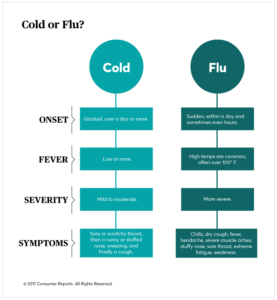Cold and Flu Season Quickly Approaching

Cold and flu season is quickly approaching. Runny noses, high fevers, sore throats, and upset stomachs are on their way. One of the main questions that we get each season from parents is how to tell if their child’s symptoms reflect the flu virus or just the common cold. There are a few easy ways that you as a parent can tell if your little one is suffering from the common cold or the flu virus. Read about a few distinguishable symptoms that come along with the flu virus.
Flu Symptoms
- Quick/onset symptoms
- High fever (101 degrees +)
- Body aches/chills and extreme fatigue
- Multi-symptom complaints (runny nose, upset stomach, headache, sore throat, etc.)
- Loss of appetite, nausea, vomiting, or even diarrhea
The common cold has far less severe symptoms that can typically be treated with over-the-counter medications. Read about a few of the symptoms associated with the common cold below:
Common Cold Symptoms
- Congestion or runny nose
- Low grade fever (below 101 degrees)
- Throat irritation or scratchiness
- Fatigue

If you as a parent notice that your little one’s symptoms are worsening, it’s always a good idea to visit your pediatrician. In the office, the pediatrician can test for the flu and can get almost immediate results. Don’t be alarmed if your child is diagnosed with the influenza virus. It’s great that you took initiative to get them to a doctor as soon as possible.
Flu Risk Factors
Now you may ask yourself how your little one was exposed to the virus? You may even take extra measures in making sure that he or she washes their hands before eating, takes their vitamins, and gets plenty of sleep. Don’t blame yourself. In fact, it’s quite common for usually healthy children to test positive for the flu in the United States.
Moreover, young children and elderly people with weaker immune systems are at the highest risk for developing upper respiratory illnesses and viral infections. There are things you can do as a parent at home that will help your little ones fight against this year’s cold and flu season. One major way that you as a parent or caregiver can help prevent the flu virus(es) from entering your home is by ensuring that everyone in your household gets a flu vaccine.

The CDC (Center for Disease Control and Prevention) does research each year on the virus that we all call the flu. Each year the virus is slightly different than the previous year. The virus is actually quite smart. In fact, it evolves each year based on the previous year’s vaccinations and the general public’s immune resistance to the virus itself. So each year we see a different virus with different symptoms with different immune responses. This makes it tough for any immune system to be prepared for the next flu season without vaccination assistance.
There are multiple methods and theories out there that either praise or shun vaccinations. If you have heard that you put yourself or your children at a higher risk for getting the flu because they received the flu shot, you have been misinformed. Seasonal influenza in the United States is extremely common, and it’s much more powerful than the common cold. If your child is in school, their risk for contracting the virus is even higher without receiving the vaccine ahead of time. Unfortunately, the vaccination is less effective once the virus has spread throughout the community. Moreover, your family should get the flu shot before the “outbreak” begins. See more on what the CDC recommends regarding time of receiving the vaccine and its effectiveness throughout the season here.
Simply washing your hands and keeping your home as clean as possible oftentimes doesn’t stand up as defense against the influenza virus or the common cold. Moreover, unlike a bacterial infection that can be treated with antibiotics, the flu virus has no cure. The treatment that may be prescribed is antiviral drugs/medications that help treat the symptoms while the virus is “running its course.”

Unfortunately, each year we see hundreds if not thousands of men, women, and children killed by the effects of the influenza virus. The CDC estimates that between 12,000-56,000 people may die of this infection yearly. Many families do not take seriously their unique risks and the severity of the setbacks of contracting the flu virus. On average, a person who tests positive for the flu is out of work or school for 5-7 days depending on their symptoms.
Aside from missing school or work, it takes a few weeks for the infected person’s immune system to regain its strength. During this time, it’s important to get lots of rest, take vitamins, eat a healthy diet, and continue to wash your hands as often as possible.
Take Action
Now that you are informed about the best ways to protect your family from this year’s upcoming cold and flu season, it’s time to take action! If you have more questions about the flu shot or its risks/side-effects, we are happy to help answer any questions or concerns you may have. Our goal at Ocoee Pediatrics is to keep your little one’s as healthy as possible. We know that this requires a team effort between you as a parent and us a your pediatrician. Together we can fight against this year’s cold and flu season, successfully!
If you want to schedule an appointment with one of our providers, or if you would like to schedule a time for your little ones to come in for their flu shots, give us a call or visit our website. We look forward to serving your family!